One of the most used resources for writing for my three oldest children when they were growing up is called Read! Write! Publish! Making Books in the Classroom”, by Creative Teaching Press.
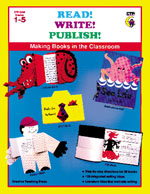
I got it early in our homeschooling journey so I didn’t think it was still purchasable, but I found it here! Basically, it is a book about making books, and the format is SO easy for the children to do on their own. Each type of book has a two page layout. The first page shows visually how to make the book and if you need to have a “blank formatting page” (found at the back of the book). The second page shows visual samples of how others created diverse books from the foundation. So, all I did was provide a stack of the various blank pages available for the books provided in the back of the book as well as other materials needed such as regular blank paper, tagboard, and other such items.
This is an especially useful tool for the right-brained learner. These children tend to develop traditionally valued writing (words to paper) later, not to mention they often dislike handwriting while young as well. Many of the books to be made in this resource capitalize on the right-brained learner’s assets: visual, three-dimensional, pictorial, creative. Some of the more popular books for my creative learners to make were: Pop-Up Book (makes sense, since it is three-dimensional!), Video Book (again, makes sense . . . it’s a picture slide show), Flip Book (again, humor mixed with pictures with minimal words), Wheel Book (making a visual with a wheel that turns), etc.
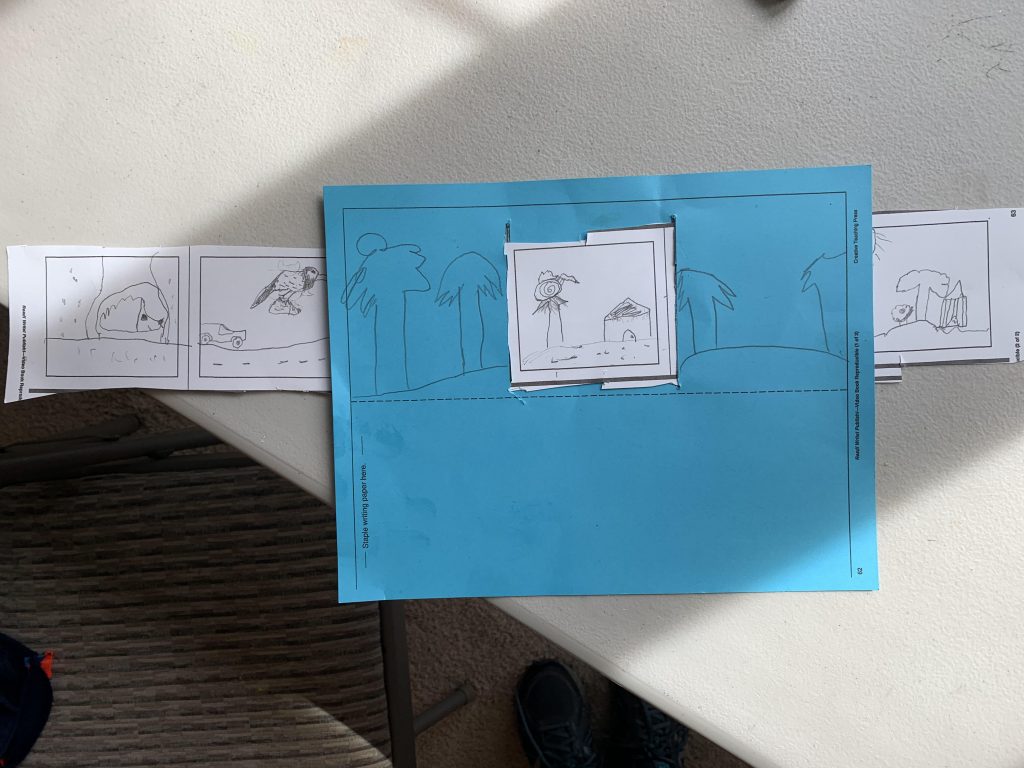
What I think this resource showed my creative learners was that books are fun, and making books is fun . . . the words and writing were secondary for many of these book ideas, so the focus was on expressing their ideas in the way that works for them, and then appreciating that they were “writing books”. There was no “writing phobia” or “dysgraphia” that surfaced because of this approach.
I’m so excited that the resource is still out there . . . I highly recommend it. Of course, if you want the potential benefits of what happened with my diverse children, you would want to use it as a resource they can use anyway they want. For instance, here are some of the “books” that I pulled out of my oldest artist son’s 8-year-old files that I know were “inspired” after using this resource as well as interrelating with various types of books:
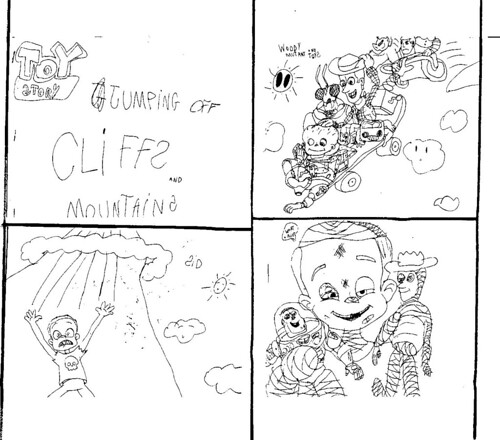
Notice that he still wrote certain letters backward, particularly “S” and “J”. He told his story more in his drawing than in the writing. In this “book” (10 pages total), which he had stapled together on plain paper, were simply labels of each picture, although as you go through the pictures, there is a story there. The last page has the declaration, “What a fliat” (flight), so there is also “invented spelling” still.

This one I was able to give as a complete sample. This is when my artist son was really into penguins. My focus on admiring his work was on the overall representation of a story, not the parts that made each up, such as the continued backward letters, invented spelling, or that there were minimal words, let alone basically labeling or putting phrases versus “complete sentences”. It was all a process, and I was amazed by how the pictures and words combined to create a lot of feeling and plot.
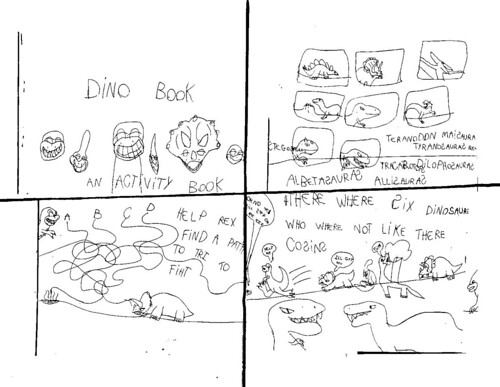
This is a dinosaur activity book. My artist son loved dinosaurs from around 3-4 years old until around this time. In this book, he did a little of everything. He started off with a few pages of labels, then a few pages of traditional activity pages, and then a mini story at the end. It was a total of 14 pages and I took a page sample from each “category.”

My artist son had a couple Lion King story books in this folder, stapled together, about 40 pages each. Again, it was a mix of words and pictures that together created a really awesome storyline. In the samples above, I liked the perspective that one often sees in a right-brained learner’s pictures, with the back of the lions’ heads looking on the scene, as well as a simple outline of the lions’ bodies running down the hill. Cool!
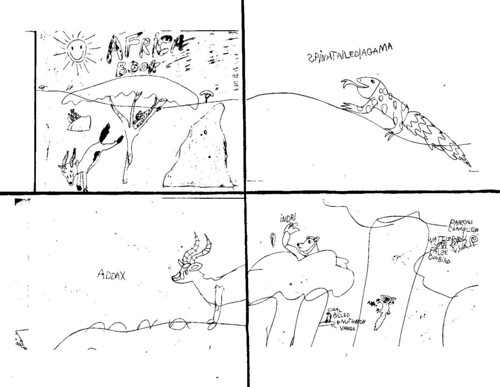
My artist son loved Africa for a good season. Here was a “book” compiled on that unperforated computer paper that you could buy in the day where it is “continuous fed and unperforated paper” so that it lies accordian style and you have to tear off the hole-punched side feed. My children used this type of paper a LOT back when. This was about a 70 page compilation and it pretty much consisted of labeling the various animals of Africa. This is how he learned about his continents and countries . . . his fascination with animals and his need to know everything about them, particularly where they lived and why and how.
There were other books in his folder. One type that showed up a lot around 9 years old were “Colorform books”. I guess I had purchased some Colorforms around that time, and he decided to make his own based on his favorite interests. My artist son would draw and color a background scene, and then meticulously draw, color and cut out the “forms” that you would play on the scene. He would then tuck these cut-outs into an envelope, which he labeled, and stuck in the place they belonged within the book pages.
My artist son was gifted in the visual area as well as had a precocious vocabulary. My builder son was more gifted in the spatial area and had a knack for math more than words. Both were strong right-brained learners with different focuses of strength. My builder son didn’t learn to read until 10-11 years old, so you will notice in his books that follow had few words. Those he did have often were very slaughtered in spelling. However, what is fun to notice between my artist son and my builder son with their books is that you can see the slant that my builder son brings toward his own right-brained gift: building. He loved Lego, trains, and numbers, and you will see that represented in his drawings. My builder son may not have been much of a story creator if not for the model from his artist brother and writer sister.
Here are some samples from my builder son’s 8 year old folder:

It was about Jack, I believe, his imaginary friend. (Right-brainers have a higher incidence of imaginary friends, and my builder son had a handful of them.) You notice how the spelling of Jack is slaughtered. Yet, the perspective in his drawing is remarkable (which can be common for right-brained learners). Also, notice that for my builder son, he liked to draw a bunch of little boxes with mini parts to his story line, not unlike Lego that are separate, but put together.
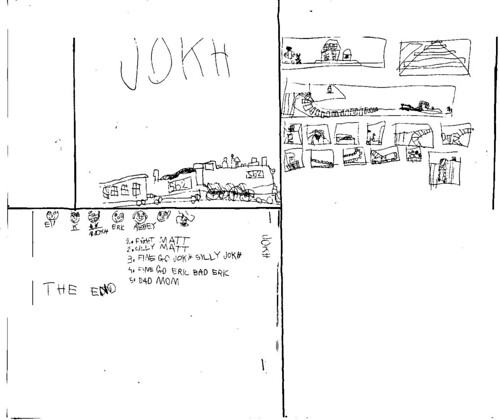
This is another Jack story, but with a train theme. Many of his books have train themes because of his great and deep love for them, beginning around 18 months old and lasting into his teen years. Also notice his limited verbal descriptions of his characters that he placed on the last page. He actually corrected his The End, which usually was The Edn for several years. Apparently, this is when he started to notice and correct it.

This is another classic example for my builder son of his book work. He had many maze-y, puzzle-y type of drawings that depicts his visual-spatial mind. He has always been my instructional reader, preferring the visual diagram and instruction versus the verbal. Notice there are no words although there appears to be visual symbols depicting some code to the puzzle. It may be based on some video games.
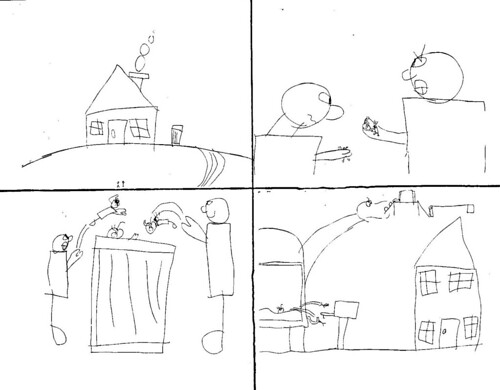
Here is a more classic story, all picture with no words, and yet, the pictures depict a thousand words, and a storyline is beginning to emerge in his books. It took him much longer to develop storylines through pictures than his older artist brother, because language was not an asset for my builder son. And yet, notice the perspective yet again (for example, see the two tiny people silhouettes in front of the house in the first picture?). . . his visualizations were quite accurate, even if words failed him!
I wanted to show at least two samples of two different types of right-brained learners. My artist son was my most naturally “smart” and would have been labeled gifted in school with no doubt. However, I’m sure he would have struggled with the classification of “not living up to his potential,” because so many of these valued school skills, such as reading, writing, handwriting, and spelling came later. He would have probably been labeled “twice exceptional,” but, he was very intelligent nonetheless.
My builder son would have been labeled disabled (he has an autism diagnosis) and put in special classes if he had attended school. No one would have noticed or given credit for his amazing spatial skills, but we did. Although the valued skills of reading, writing, spelling, vocabulary, English, speaking, etc., came well later for him, they were put in perspective as we focused on the skills that did emerge for him early on. Building, spatial skills, math, music, and a highly sensitive heart were nurtured young, and when the other skills that were delayed began to emerge, these assets of his that had been well developed helped him capitalize more easily in bringing everything together. I have no doubt he would not be the child he is today if he had not been homeschooled, and valued for the perspective and skills that surfaced, and being encouraged by bringing in the resources that he could build on, which included a lot of trains, tracks and Lego as his core homeschooling foundation in the early years. It has served him well!
In conclusion, what I saw was that once this initial resource showed my children that they could make their own books of all sorts of types and styles and functions and focus, they began to make books of their own creation often inspired by other resources that came into the home. They discovered that even if you couldn’t find a particular resource about their favorite interest, they could create it themselves! For a right-brained learner, I think it’s all about resources that inspire, not resources that dictate.






Pingback: Writing in the Teen Years – A Natural Progression |